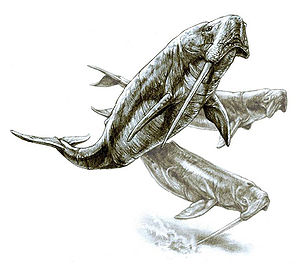Odobenocetops
| Odobenocetops | ||||||||||||
|---|---|---|---|---|---|---|---|---|---|---|---|---|

Odobenocetops , a male in front, a female at the top, a male below. |
||||||||||||
| Temporal occurrence | ||||||||||||
| Upper Miocene to Lower Pliocene ( Zancleum ) | ||||||||||||
| 9.03 to 3.6 million years | ||||||||||||
| Locations | ||||||||||||
| Systematics | ||||||||||||
|
||||||||||||
| Scientific name of the family | ||||||||||||
| Odobenocetopsidae | ||||||||||||
| de Muizon & McDonald , 1993 | ||||||||||||
| Scientific name of the genus | ||||||||||||
| Odobenocetops | ||||||||||||
| de Muizon & McDonald, 1993 | ||||||||||||
Odobenocetops (Greek odon - "tooth", baino - "to go" and Latin cetus - "whale", ops - "like", so "whale who walks like on his teeth", but it also refers to the similarity to the walrus ( Odobenus ).) is an extinct genus of whales . Fossils of the genus have been found in the Pisco Formation on the Pacific coast of Peru and in the Bahía Inglesa Formation on the Pacific coast of Chile . It lived from the Upper Miocene around 9.03 to 6.45 million years ago to the Lower Pliocene from 5.33 to 3.6 million years ago. So far, two species have been described, the type species Odobenocetops peruvianus and Odobenocetops leptodon .
features
Odobenocetops were 2.1 to three meters long. The whale did not have an elongated snout, but rather long, asymmetrical tusks that sat in a rearward-facing intermaxillary bone (premaxillary). In a skull of Odobenocetops leptodon , the right tusk was 1.35 meters long, while the left, whose tip was broken off, only reached a length of 25 centimeters. According to the descriptive scientists, the skull belonged to a male animal. The females had shorter tusks of the same length. When swimming, the long tusk had to be kept parallel to the body axis. Strong muscle attachment points at the front of the intermaxillary bone speak for strong lips on the upper jaw. The upper jaw was otherwise toothless, the palate strongly arched. The eyes were on the top of the head and possibly enabled binocular vision. Of the two species, O. peruvianus had no melon organ . In O. leptodon there are indications of a small melon and the species therefore had the option of echolocation.
The scientists adopt a diet similar to that of a walrus, that is, Odobenocetops fed on mussels, took in the soft tissues and spat out the shell again.
Systematics
Odobenocetops is placed in a family of its own, the Odobenocetopsidae. It is assigned to the dolphin-like (Delphinoidea). The closest relatives are the narwhal and the white whale , the only two species in the family of the green whale (Monodontidae).
literature
- Christian de Muizon: Walrus-like feeding adaptation in a new cetacean from the Pliocene of Peru. In: Nature . 365, 1993, pp. 745-748.
- Christian de Muizon, Daryl P. Domning, Mary Parrish: Dimorphic tusks and adaptive strategies in a new species of walrus-like dolphin (Odobenocetopsidae) from the Pliocene of Peru. In: Comptes Rendus de l'Académie des Sciences. Series IIA: Earth and Planetary Science. 329, 6, 1999, ISSN 0764-4450 , pp. 449-455.
- Nicholas D. Pyenson, Carolina S. Gutstein, James F. Parham, Jacobus P. Le Roux, Catalina Carreño Chavarría, Holly Little, Adam Metallo, Vincent Rossi, Ana M. Valenzuela-Toro, Jorge Velez-Juarbe, Cara M. Santelli , David Rubilar Rogers, Mario A. Cozzuol, Mario E. Suárez: Repeated mass strandings of Miocene marine mammals from Atacama Region of Chile point to sudden death at sea. In: Proceedings of the Royal Society B. 281, No. 1781, 2014, doi: 10.1098 / rspb.2013.3316 (PDF, royalsocietypublishing.org ).
Web links
- Johannes Albers: The grotesque walrus whales of Peru: Odobenocetops.
- The Paleobiology Database Odobenocetops
- Website with the research results from the Cerro Ballena site in the Chilean Atacama Desert , Bahía Inglesa Formation: cerroballena.si.edu
